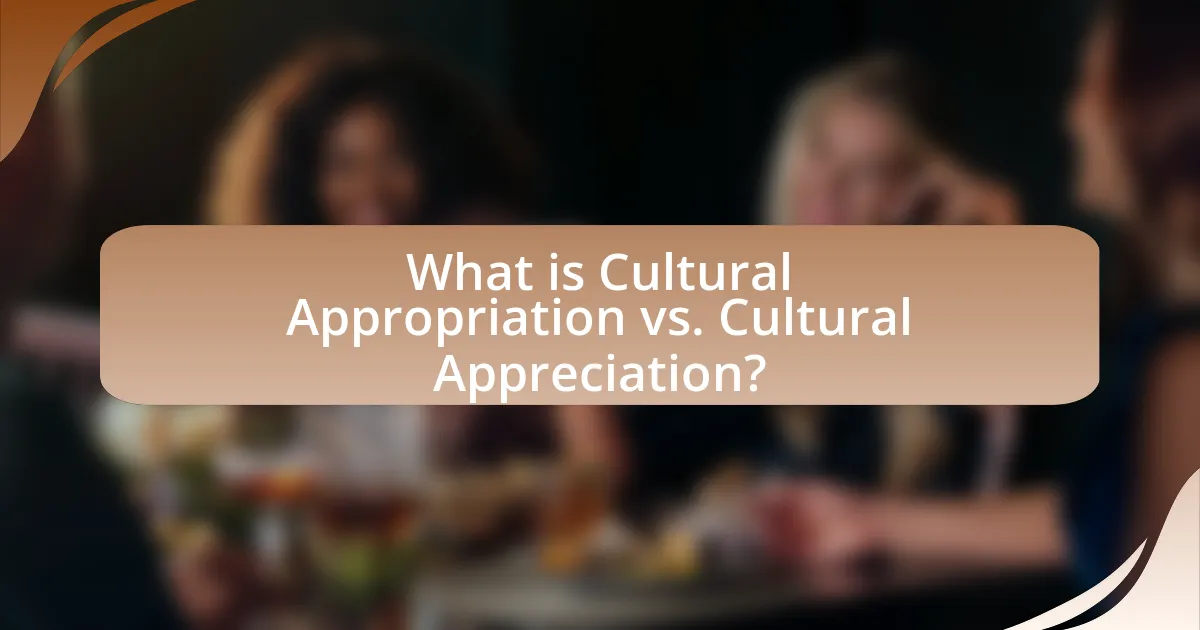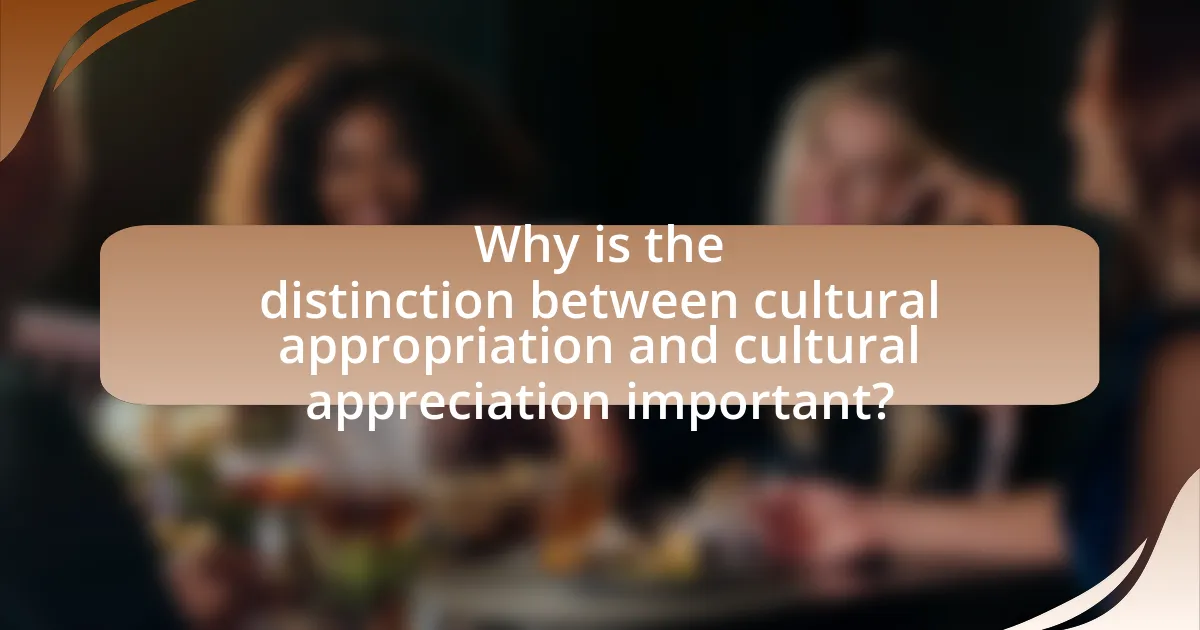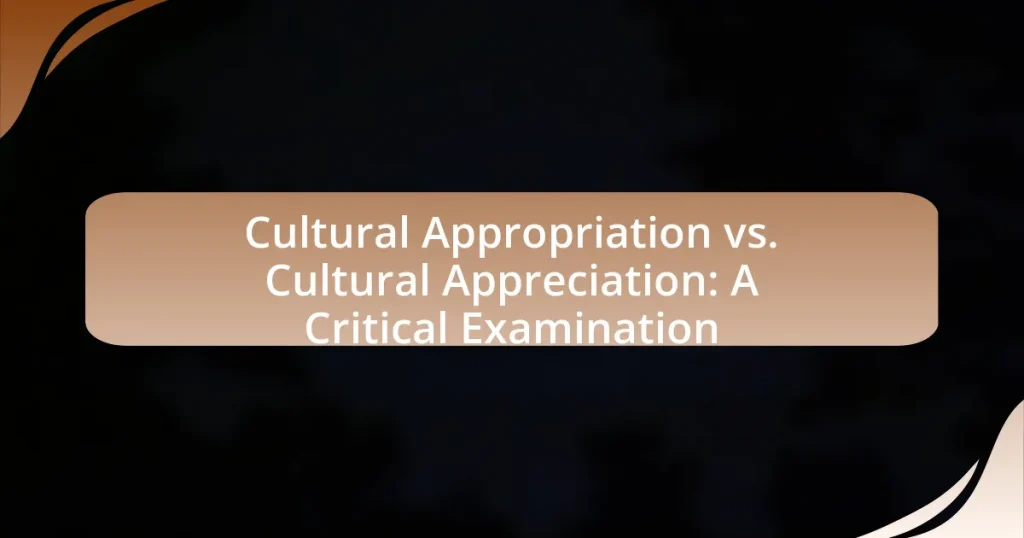Cultural appropriation and cultural appreciation are two distinct concepts that address the interaction between different cultures. Cultural appropriation refers to the unacknowledged or inappropriate adoption of elements from one culture by members of another, often leading to exploitation and reinforcing stereotypes. In contrast, cultural appreciation involves respectful engagement and understanding of another culture’s practices and beliefs. This article examines the definitions, historical contexts, key characteristics, and implications of both concepts, highlighting the importance of intent and power dynamics in cultural exchanges. It also discusses the potential harms of cultural appropriation and the benefits of cultural appreciation, providing guidance on how individuals can navigate these complex issues respectfully.

What is Cultural Appropriation vs. Cultural Appreciation?
Cultural appropriation involves the adoption of elements from one culture by members of another culture, often without permission or understanding, leading to a power imbalance and potential exploitation. In contrast, cultural appreciation refers to the respectful engagement with and understanding of another culture, acknowledging its significance and context. For example, wearing traditional attire from another culture in a respectful manner, while understanding its history and meaning, exemplifies appreciation, whereas using that attire as a costume for entertainment without context exemplifies appropriation. This distinction is crucial in discussions about cultural sensitivity and respect.
How do we define cultural appropriation?
Cultural appropriation is defined as the act of taking or using elements from one culture by members of another culture, often without permission or understanding. This practice typically involves a power imbalance, where the dominant culture appropriates aspects of a marginalized culture, leading to exploitation and misrepresentation. Historical examples include the adoption of Native American headdresses by non-Indigenous individuals, which disregards their cultural significance and context.
What are the historical contexts of cultural appropriation?
Cultural appropriation has historical contexts rooted in colonialism, globalization, and power dynamics. Throughout history, dominant cultures have often adopted elements from marginalized cultures, frequently without permission or understanding, leading to exploitation and misrepresentation. For example, during the colonial era, European powers appropriated indigenous art, clothing, and rituals, stripping them of their original significance while commodifying them for profit. This pattern continued into the 20th century, where elements of African American culture, such as jazz and hip-hop, were appropriated by mainstream culture, often benefiting those in power while the original creators faced systemic discrimination. These historical instances illustrate how cultural appropriation is intertwined with issues of inequality and dominance, highlighting the need for awareness and sensitivity in cultural exchanges.
What are the key characteristics of cultural appropriation?
Cultural appropriation is characterized by the adoption of elements from one culture by members of another culture, often without permission or understanding. This practice typically involves a power imbalance, where the dominant culture appropriates aspects of a marginalized culture, leading to exploitation and commodification. Key characteristics include lack of context, where cultural symbols are used superficially; disrespect, as the original meanings are often ignored; and economic benefit, where the appropriating culture profits while the source culture does not. Historical examples, such as the commercialization of Native American headdresses in fashion, illustrate these characteristics, highlighting the ongoing issues of cultural sensitivity and respect.
How do we define cultural appreciation?
Cultural appreciation is defined as the respectful understanding and valuing of another culture’s practices, beliefs, and contributions. This involves engaging with the culture in a way that acknowledges its significance and context, rather than exploiting or misrepresenting it. For example, participating in cultural traditions, learning about their history, and supporting artists from that culture exemplify cultural appreciation. This concept is validated by anthropological studies that emphasize the importance of mutual respect and understanding in intercultural interactions, highlighting that genuine appreciation fosters positive relationships and cultural exchange.
What are the historical contexts of cultural appreciation?
Cultural appreciation has historical contexts rooted in the interactions between diverse societies, particularly during periods of colonization, trade, and globalization. For instance, during the Age of Exploration in the 15th to 17th centuries, European powers encountered various cultures, leading to exchanges that were often framed as appreciation but frequently resulted in exploitation and appropriation. The Romantic movement in the 18th and 19th centuries also highlighted a fascination with non-Western cultures, promoting an appreciation that sometimes overlooked the complexities of those cultures. Additionally, the civil rights movements of the 20th century prompted a reevaluation of cultural exchanges, emphasizing the importance of respect and understanding in appreciating cultural differences. These historical contexts illustrate that cultural appreciation is often intertwined with power dynamics and social relations, shaping how cultures are perceived and valued over time.
What are the key characteristics of cultural appreciation?
Cultural appreciation is characterized by respect, understanding, and genuine interest in another culture. This involves actively seeking knowledge about cultural practices, values, and beliefs, while recognizing their significance and context. For instance, engaging with cultural elements through education, participation, and collaboration demonstrates a commitment to honoring the culture rather than exploiting it. Additionally, cultural appreciation emphasizes the importance of acknowledging the contributions of the culture’s originators, which fosters mutual respect and dialogue.
What are the main differences between cultural appropriation and cultural appreciation?
Cultural appropriation involves the unacknowledged or inappropriate adoption of elements from one culture by members of another culture, often without understanding or respect for the original context. In contrast, cultural appreciation entails a respectful acknowledgment and understanding of another culture, often involving engagement and learning about its traditions and values. For example, wearing traditional attire from another culture in a respectful context, such as a cultural festival, exemplifies appreciation, while using that attire as a costume for entertainment without context exemplifies appropriation. This distinction is crucial as appropriation can perpetuate stereotypes and exploit marginalized cultures, whereas appreciation fosters mutual respect and understanding.
How do power dynamics influence cultural appropriation and appreciation?
Power dynamics significantly influence cultural appropriation and appreciation by determining who has the authority to adopt elements from another culture. When a dominant culture appropriates aspects of a marginalized culture, it often does so without understanding or respecting the original context, leading to exploitation and misrepresentation. For instance, the commercialization of Indigenous symbols by fashion brands exemplifies how power imbalances can result in cultural appropriation, as these brands profit from sacred symbols while the originating communities face systemic oppression. Conversely, cultural appreciation occurs when individuals from a dominant culture engage with another culture respectfully and knowledgeably, often fostering mutual understanding and respect. This distinction highlights that power dynamics shape the ethical implications of cultural exchange, with appropriation often reinforcing existing inequalities, while appreciation can promote cultural dialogue and respect.
What role does intent play in distinguishing between the two concepts?
Intent plays a crucial role in distinguishing between cultural appropriation and cultural appreciation. Cultural appropriation typically involves the adoption of elements from one culture by members of another culture, often without understanding or respecting the original context, which can lead to exploitation. In contrast, cultural appreciation involves a respectful engagement with another culture, characterized by understanding, acknowledgment, and a genuine desire to learn and honor that culture. For example, when individuals participate in cultural practices with permission and understanding, it reflects appreciation, whereas using cultural symbols for profit or fashion without consent exemplifies appropriation. This distinction underscores the importance of intent in evaluating the ethical implications of cultural interactions.

Why is the distinction between cultural appropriation and cultural appreciation important?
The distinction between cultural appropriation and cultural appreciation is important because it affects the dynamics of power, respect, and identity between cultures. Cultural appropriation involves the unacknowledged or inappropriate adoption of elements from one culture by members of another, often leading to exploitation and reinforcing stereotypes, while cultural appreciation entails a respectful understanding and acknowledgment of another culture’s practices and beliefs. For example, when fashion designers use traditional Indigenous patterns without permission or context, it exemplifies appropriation, whereas participating in cultural exchange through education and collaboration reflects appreciation. This distinction is crucial for fostering mutual respect and understanding, as it helps prevent cultural exploitation and promotes genuine intercultural dialogue.
What are the potential harms of cultural appropriation?
Cultural appropriation can lead to significant harms, including the commodification of marginalized cultures, the erasure of cultural identity, and the perpetuation of stereotypes. When dominant cultures adopt elements from marginalized cultures without understanding or respecting their significance, it often results in a superficial representation that strips away the original context and meaning. This commodification can exploit cultural symbols for profit, as seen in fashion and music industries, where traditional attire or practices are commercialized without acknowledgment of their origins. Furthermore, cultural appropriation can contribute to the erasure of the histories and identities of marginalized groups, as their cultural expressions are misrepresented or trivialized. This dynamic reinforces harmful stereotypes, as dominant cultures may portray marginalized cultures in ways that are inaccurate or reductive, perpetuating biases and misunderstandings.
How can cultural appropriation perpetuate stereotypes?
Cultural appropriation can perpetuate stereotypes by misrepresenting and oversimplifying the cultural practices and identities of marginalized groups. When dominant cultures adopt elements from minority cultures without understanding their significance, they often reduce complex traditions to superficial trends, reinforcing harmful stereotypes. For instance, the commercialization of Native American headdresses in fashion often ignores their cultural importance and the historical context of oppression faced by Indigenous peoples, leading to a distorted perception that trivializes their identity. This misrepresentation can contribute to societal misconceptions, further entrenching stereotypes and diminishing the authenticity of the original culture.
What impact does cultural appropriation have on marginalized communities?
Cultural appropriation negatively impacts marginalized communities by perpetuating stereotypes and undermining their cultural significance. When dominant cultures adopt elements from marginalized cultures without understanding or respecting their origins, it often leads to misrepresentation and commodification. For instance, the use of traditional Indigenous attire in fashion shows can strip away the cultural and spiritual meanings attached to those garments, reducing them to mere trends. This appropriation can also result in economic disadvantages for marginalized groups, as their cultural expressions are exploited for profit by those outside the community, while the original creators remain unrecognized and unrewarded. Studies have shown that such practices can contribute to the erasure of cultural identities and histories, further marginalizing these communities in societal narratives.
What are the benefits of cultural appreciation?
Cultural appreciation fosters mutual respect and understanding among diverse communities. By engaging with and valuing different cultures, individuals can enhance their social awareness and empathy, leading to stronger interpersonal relationships. Studies indicate that cultural appreciation can reduce prejudice and promote inclusivity, as seen in research published by the American Psychological Association, which highlights how exposure to diverse cultures can diminish stereotypes and biases. Furthermore, cultural appreciation encourages the preservation of cultural heritage, as communities feel valued and recognized, which can lead to increased efforts in maintaining traditions and practices.
How can cultural appreciation foster understanding and respect?
Cultural appreciation fosters understanding and respect by promoting awareness and knowledge of diverse traditions and values. When individuals engage in cultural appreciation, they actively seek to learn about and celebrate the customs, beliefs, and practices of different cultures, which leads to a deeper understanding of their significance. This process reduces stereotypes and misconceptions, as evidenced by studies showing that exposure to different cultures can enhance empathy and reduce prejudice. For instance, research published in the Journal of Cross-Cultural Psychology indicates that cultural exposure through appreciation can lead to more positive attitudes towards other groups. By valuing and respecting cultural differences, individuals contribute to a more inclusive society where mutual respect thrives.
What role does cultural exchange play in appreciation?
Cultural exchange plays a crucial role in fostering appreciation by facilitating mutual understanding and respect among diverse cultures. Through the sharing of traditions, art, and practices, individuals gain insights into the values and histories of other cultures, which enhances their appreciation for those cultures. For instance, programs like cultural festivals and exchange student initiatives have been shown to increase cultural awareness and empathy, as evidenced by studies indicating that participants in such programs report a greater appreciation for cultural diversity. This exchange not only enriches personal experiences but also contributes to a more inclusive society by breaking down stereotypes and promoting dialogue.

How can individuals navigate cultural appropriation and appreciation in practice?
Individuals can navigate cultural appropriation and appreciation by engaging in respectful dialogue and education about the cultures they wish to appreciate. This involves understanding the historical context and significance of cultural elements, such as clothing, music, or rituals, to avoid misrepresentation or exploitation. For instance, when adopting traditional attire, individuals should research its origins and meaning, ensuring they honor the culture rather than commodify it. Engaging with members of the culture, supporting their work, and amplifying their voices can further demonstrate appreciation rather than appropriation. This approach is supported by scholars who emphasize the importance of context and intent in cultural exchanges, highlighting that genuine appreciation fosters mutual respect and understanding.
What steps can individuals take to ensure cultural appreciation is respectful?
Individuals can ensure cultural appreciation is respectful by actively engaging with and learning about the culture they wish to appreciate. This involves researching the history, significance, and context of cultural practices, symbols, and artifacts to avoid misrepresentation. For example, understanding the origins of traditional clothing or music can prevent individuals from using them inappropriately. Additionally, individuals should seek permission from cultural representatives when appropriate and support creators from that culture, thereby promoting authenticity and respect. Engaging in open dialogues with members of the culture fosters mutual understanding and respect, which is essential for genuine appreciation.
How can one engage with another culture authentically?
To engage with another culture authentically, one should prioritize active listening and open-mindedness while participating in cultural practices. This involves immersing oneself in the culture through genuine interactions, such as attending cultural events, learning the language, and building relationships with individuals from that culture. Research indicates that authentic engagement fosters mutual respect and understanding, as seen in studies highlighting the positive outcomes of cultural exchange programs, which enhance intercultural competence and reduce stereotypes. By approaching another culture with respect and a willingness to learn, individuals can create meaningful connections that honor the culture’s traditions and values.
What are some examples of respectful cultural exchange?
Respectful cultural exchange includes practices such as collaborative art projects, where artists from different cultures work together to create pieces that honor both traditions, and cultural festivals that celebrate diverse heritages while ensuring representation and participation from the communities involved. For instance, the Smithsonian Folklife Festival showcases various cultures through shared experiences and mutual respect, allowing participants to engage authentically with different traditions. Additionally, educational programs that promote language learning and cultural understanding foster respectful exchanges by encouraging dialogue and appreciation rather than appropriation. These examples illustrate how cultural exchange can be conducted in a manner that respects and honors the origins and significance of cultural practices.
What resources are available for further understanding cultural appropriation and appreciation?
Resources for further understanding cultural appropriation and appreciation include academic books, articles, and online courses. Notable books such as “Who Owns Culture? Appropriation and Authenticity in American Law” by Susan Scafidi provide legal perspectives, while “Cultural Appropriation and the Arts” by James O. Young offers philosophical insights. Scholarly articles, like “Cultural Appropriation: A Framework for Understanding” published in the Journal of Cultural Studies, present empirical research and case studies. Online platforms like Coursera and edX offer courses on cultural studies that address these topics. These resources collectively enhance comprehension of the nuances between cultural appropriation and appreciation.
Where can one find educational materials on cultural sensitivity?
Educational materials on cultural sensitivity can be found through various reputable sources, including academic institutions, online platforms, and nonprofit organizations. For instance, universities often provide resources through their diversity and inclusion departments, while websites like the American Psychological Association offer articles and guidelines on cultural competence. Additionally, organizations such as the National Multicultural Institute publish training materials and workshops focused on cultural sensitivity. These sources are credible and widely recognized in the field of cultural education.
What organizations promote cultural awareness and appreciation?
Organizations that promote cultural awareness and appreciation include the United Nations Educational, Scientific and Cultural Organization (UNESCO), which focuses on fostering international collaboration through education, science, and culture. Additionally, the National Endowment for the Arts (NEA) in the United States supports artistic endeavors that celebrate diverse cultural expressions. The Asia Society also plays a significant role in promoting understanding and appreciation of Asian cultures through various programs and initiatives. These organizations contribute to cultural awareness by providing resources, funding, and platforms for cultural exchange and education.










